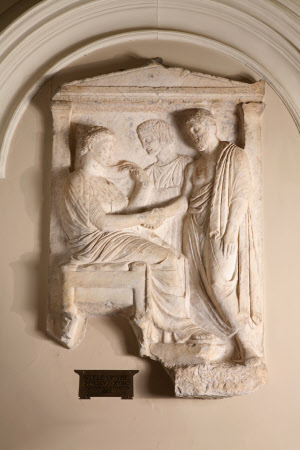Funerary stele for Melisto and Epigenes
Category
Art / Sculpture
Date
circa 500 BC - circa 400 BC
Materials
Marble
Measurements
1500 x 850 mm
Place of origin
Athens
Order this imageCollection
Lyme, Cheshire
NT 500255.2
Summary
Marble stele (slab) of the fourth century BC, from Athens, depicting three figures. A stele in the naiskos (small temple) style) depicts three figures, two of which are carved in high relief. A Greek inscription records the names of the individuals commemorated with their patronymics and deme-names: ‘Melisto (daughter) of Hegestratos of Oion. Epigenes son of Mikrion of Eleusis’.
Full description
A marble stele in the shape of a naiskos (small temple) depicting three figures, two of which are carved in high relief. White-ish marble with pediment; acroteria are damaged or missing; the stele is broken at the lower left-hand corner. In the pediment, traces of a horizontal and a vertical stroke perpendicular to each other may be the result of subsequent damage. There are minor nicks all over the surface of the marble and the figures. The faces of all three figures – particularly that of the seated female – appear to have been damaged deliberately. The inscription is written on the architrave and is cut clearly and evenly with letters of a style characteristic of the mid fourth century BC. It records the names of the individuals commemorated with their patronymics and deme-names: ‘Melisto (daughter) of Hegestratos of Oion. Epigenes son of Mikrion of Eleusis’. Melisto is represented as a young woman and is seated on a chair without a back (diphros); she is depicted clasping hands (in dexiosis) with a bearded, mature, male who is probably Epigenes. The female figure in the background, sculptured in lower relief, is likely to be an enslaved person. As Melisto clasps hands with Epigenes, she appears to be about to remove her veil with her left hand; this gesture (known as anakalypsis) can, like dexiosis, often be a signifier of intimacy, but it can also evoke married status, as it appears to do here. Given the iconography it is likely, therefore, that the two principal figures represented on this stele were married; moreover . Their demotics demonstrate that they were Athenian citizens. The third figure bears a box, possibly a jewellery casket, which might represent the wealth brought to the household in the form of Melisto’s dowry. For more discussion, see Attic Inscriptions Online: https://www.atticinscriptions.com/inscription/AIUK5/2 (Peter Liddel, 2021)
Provenance
Collected by Thomas Legh (1792-1857, who inherited the Lyme estate in 1797), in 1811 or 1821, probably in Athens, possibly in area of the Kerameikos cemetery. This object, along with another funerary stele and a piece of inscribed sculpture, were installed in Lyme Hall’s remodelled Library for Thomas Legh by the architect Lewis Wyatt.
Marks and inscriptions
Melisto the Daughter of Hegestratos from Oion (?), Epigenes son of Mikron(?) from Elenois (?) (a translation of the Greek. Carved below the pediment)
References
Attic Inscriptions Online translation and commentary: https://www.atticinscriptions.com/inscription/AIUK5/2 Liddel and Low 2019: Peter Liddel and Polly Low, Attic Inscriptions in UK Collections. Volume 5. Lyme Park (2019). Online publication: https://www.atticinscriptions.com/papers/aiuk/-5/ Liddel & Low 2021: Peter Liddel & Polly Low 'Ancient Athenian Inscriptions at Petworth House, Lyme and Mount Stewart', National Trust Art, Buildings and Collections Bulletin, Autumn 2021, pp. 22-6 Oliver 2000: G.J. Oliver, ‘Images of Death: Inscribed Funerary Monuments from Fourth-Century Athens in Neo-Classical England’, in A. Cooley (ed.), The Afterlife of Epigraphy, Bulletin of the Institute of Classical Studies Supplement 75 (2000), 125-41. Strong, Eugénie, 1860-1943 Three sculptured stelai : in the possession of Lord Newton at Lyme Park / [1903]

